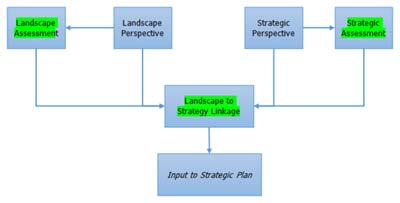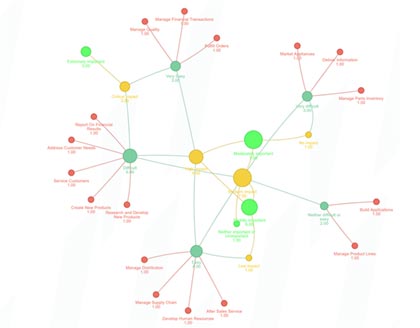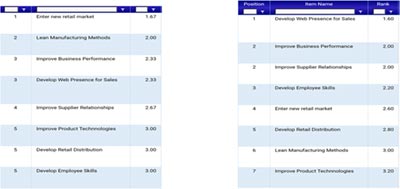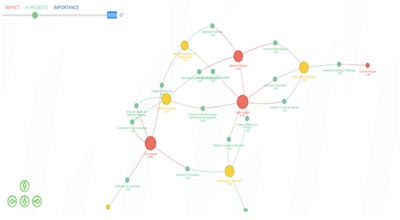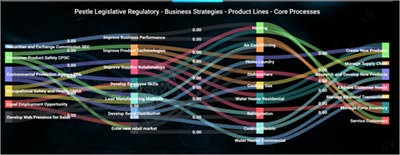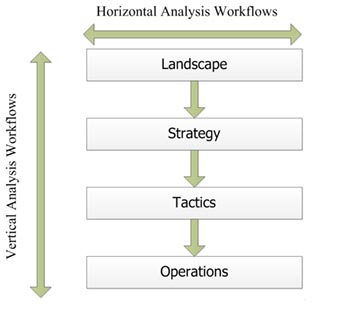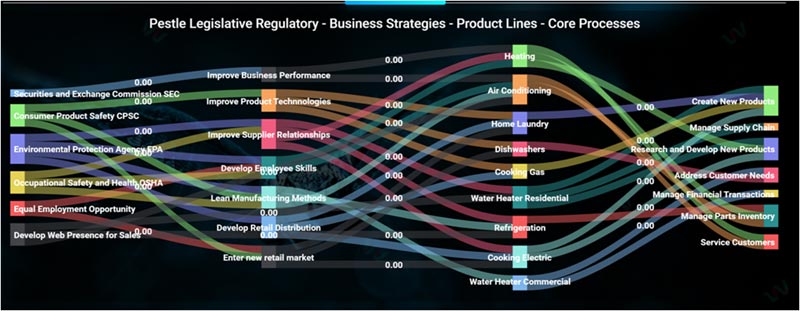
Business and IT Architecture (14)
Organizations are faced with high-demand response to changing business conditions. The business and IT Architecture certification provides and insight into the different dimensions associated with architectural thinking. Enterprise Architecture, as used in the industry today, is focused on information technology delivery and services. But, does not address a number of critical organizations considerations not part of the information technology environment. This certification is designed to assist someone to be versed in the differences associated with sets of business architectures that have a significant influence on the organization.
Business Analytics Solutions
The use of advanced and emerging analytics is no longer limited to data scientists only. Advances in technology and the increasing availability of user-friendly analytics software have made it easier for managers and the various types of analysts to leverage the power of data-driven insights. These analytics help managers make better decisions, identify trends and patterns, and optimize their operations.
In addition to traditional statistical analytics, there are also newer approaches such as semantic analytics that can provide even more valuable insights. For example, semantic analytics can analyze unstructured data such as text, images, and audio to uncover patterns and trends that might not be apparent from structured data alone.
Extending the use of analytics to business analysis can bring significant benefits to an organization. By leveraging analytics, business analysts can gain deeper insights into customer behavior, strategic alignment, market trends, and operational performance. They can use this information to identify areas for improvement, optimize processes, and make better-informed decisions.
Business Analytics for Managers and Analysts
Written by Frank Kowalkowski
Business Analytics Solutions
Landscape impacts on your strategies
The PESTLE framework has become a standard approach in analyzing the external landscape of the organization. By understanding how the political, economic, social, technology, legislation, and environmental factors all impact your strategic direction, you’ll be in a better position to meet or excel in the challenging new circumstances.The Wizsm Landscape Impact workflow is built around analytics that work with known management approaches, such as PESTLE. Wizsm brings both a semantic and a quantitative view of external impacts on strategic direction. The workflow begins with organizing what we know about the external environment and then linking that semantically with strategic statements and typical characteristics such as impact, importance, risk level and so on.
To determine what is known about the external ecosystem of the business, PESTLE looks at 6 key areas. Briefly these PESTLE components are:
- P – Political – What are the political situations that affect your organization and what type of impacts do they have?
- E – Economic – What economic factors are you most concerned with?
- S – Social - What social trends are most important to your organization?
- T – Technology – What technologies are you most exposed to that determine the direction of your products and services?
- L - Legislative - What new laws or regulations are you concerned with?
- E – Environment – What environmental changes or concerns help or hinder your organization?
- M – What are the markets of interest to your organization?
- B – What issues do business executives think are important today?
Strategic Alignment Overview
- Strategic Alignment is a subset of business alignment
- Strategic Alignment relates the landscape to the strategic perspective of the organization
- Landscape analysis is based on the PESTLE approach extended to PESTLE-MB
- Strategic analysis is based on the strategic categories of the organization
Unique Strategic Alignment Analytics
Following ‘Path to Point’ analysis of properties of the core processes of an organization showing the links of Importance and Impact of a process.
- Landscape analysis is based on the PESTLE approach extended to PESTLE-MB
- Common Categories of PESTLE: Political, Economic, Social, Technology, Legislative (e.g. regulatory), Environment
- Plus: Markets and Business Concerns
- Strategic Analysis is based on the Strategic categories of the Organization such as: Strategies, Initiatives, Risk, Capabilities, And so on...
Special analytics are needed to make this happen
Business Alignment
Business alignment: Connects the landscape to operations through 4 perspectives shown below. The goal is traceability of external impacts through the four perspectives (and the reverse) to assess potential impact of external and internal change to the performance, viability, and survival of the organization. A key goal is reducing the number of unknown relationships and increasing the quality, reliability and value of decision making. No decision has 100% probability. You are lucky to have 70% success. Organizations say just having a better than 50% success rate is good as it says you are minimally ahead of the game.
Business alignment can be done end-to-end, applied in part, such as aligning the strategic view with the tactical view or tactical with operational view. It can also be done top-down, bottom-up or middle out. Bottom-up (reverse analysis) is used to assess impact of operational changes like applying AI for hyper automation on strategic direction. Tools with current and emerging management analytics (E.G. Wizsm from IYCON) provide key insight from linking together the different perspectives of the organization, identifying missing, important, or irrelevant linkages and ranking the factors that are most important to the organization.
Business Alignment Overview
What is it?Business Alignment analysis is used for analyzing organization structure changes such as:
- Mergers & Acquisitions
- Consolidations
- Divestitures
- Reorganizations
- Expansion/Contraction
- As – Is/To – Be analysis and so on
- Business Alignment is an analytical method of assessing change options on an organization
Business Alignment – The Complete Picture
Incremental alignment can be done independently and then linked using a common set of management analytics
Business Alignment Analytics
- Unique algorithms such as ‘Path to Point’ provide graphic insight that exposes relationships that are part of the planning and execution linkage
- Here we see the potential impact of legislative changes on the core processes of th organization
- Insight like this is key as to where to focus automation and improvement efforts for processes
Digital Transformation
Digital transformation is the process of evolving an organization from its current state to a highly digital or even fully digital state.Digital transformation is real. It is part of a long cycle of change that relates to digital disruption that reflects the impact of digital technology on economics. Long term organization viability and survival requires a digital transformation strategy and approach in order to stay in business.
Three things are needed to make digital transformation happen:
- A digital twin to test ideas and look at options
- A list of available technologies that are used for the transformation
- Analytics applied to the digital twin that evaluate and rank the options
Customer/Consumer Behavior
Key analytics available in Wizsm provide the focus you need to identify marketing and selling opportunities:- Understanding what products or services correlate with each other
- Identifying what products or services tend to be purchased in pairs
- Connecting the first two with observing trends in sales to take advantage of in order to grow your market.
This is the typical scenario of ‘people who bought this book also bought that book’ or ‘people who bought this product also bought that related product’. These insights arm the sales effort with focused opportunities leading to increased sales in the products and services that show the most promise.
Operational Consolidation
When simplifying an organization, the first observation needed is whether things can be consolidated. It can be processes, databases, organizations, locations or other factors of the enterprise.Wizsm provides semantic comparative analytics that identify which items in two organization, processes etc. are the same, or different. Using this analytic, managers or the analyst can decide by the degree of overlap whether consolidation is difficult or easy. The most common use is consolidating two or more processes to get a corporate standard such as for hiring or payments etc.
Applying combinations of factors for comparisons, managers or analysts can see which of a group of organizations is a best fit and is a good candidate for merger or acquisition. This increases the chances of success in the restructuring of the organization.
SWOT Analysis
Most management decisions are predicated upon knowing the Strengths, Weaknesses, Opportunities, and Threats associated with a problem or situation in which an objective is known. SWOT Analysis is traditionally used in strategic planning activities. Strengths and weaknesses are used to reflect internal factors within the organization while opportunities and threats are external to the organization. But SWOT analysis can be applied in many other decision-making situations.Wizsm analytic flows provide a quick means to capture relevant SWOT perspectives across participants to assess the risks or rewards. It helps to focus on the actions that need to take place to achieve desired outcome. With Wizsm’s semantic analytics, you can identify possible relationships associated with the descriptions of each item. The evaluation of the hidden relationships from the semantics opens possibilities not considered before. Various matrices associated with these relationships also provide insights that point to the actions that are desired.
Business Innovation
Organizations constantly look for actions they can take that assure their continued growth and survival.Without a means to capture, understand, consolidate, test, and implement ideas, an organization faulters. Innovation and digital transformation are driven by a constant flow of ideas that are assessed for risk and impact on the organization. It means these ideas produce new revenue opportunities, optimizing existing channels and, ultimately, generating higher profits within existing products or services or completely new.
Wizsm’s analytics gives management a way to gain insight into the various ideas and their potential impact on the organization’s ability to change. Then, the resulting innovation chosen from those ideas can be examined and evaluated prior to executing the change on its products, services or both.
More...
Mergers and Acquisitions
How can you increase the probability of M&A success? Keeping in mind that most M&A analysis is based on financial, market, product and legal similarities and differences the real value comes from the capability of comparing the operations. Comparisons of operations are usually glossed over as too expensive so a series of interviews with executives is substituted for a more extensive analysis.The goal of an M&A analysis depends on the purpose of the M&A. What the organization need you are trying to fulfill:
- If the goal is complementary, then you are looking at differences to expand your reach
- If the goal is economics of scale, then you are looking at similarities to reduce costs or keep a competitor out of the market.
Risk
Every organization needs information about threats they face whether they are from competitors, or from the external landscape. The idea of risk assessment has been around for a long time and has well established methods of assessing riskRisk assessment starts with gathering information on threats that impact the organization. It usually begins with the strategic level and includes all types of threats such as environmental (storms, flood etc.), cyber threats, sabotage, competitive and so on. More advanced methods also use organization, operational, IT and product threat assessments.
What is missing is the capability to link all these together and determine composite horizontal and vertical risk assessments providing a comprehensive risk perspective. Assessments include many factors other than impact and likelihood. These factors include remediation cost, loss, difficulty, importance and other factors that focus the risk analysis on those threats of most significance.
Linking risk assessments together provides a valuable piece of insight for the organization. Using Wizsm hidden relationship analysis, critical risk connections are revealed, and the organization improves the insight into the more fragile parts of the organization that need protection and monitoring.
Decision Analytics for Managers and Analysts
A key part of managing an organization is making decisions. Decision involve choosing between options and understanding the impact of changes in the decision factors. Having the most achievable, accurate, and meaningful decision results improves the overall performance of any organization. Decisions are part of processes, performance reporting, incident response and direction interest. Decisions are expansive covering the overall direction of an organization in response to external threats or very detailed providing input to options in a process.Specific tools, methods and techniques provide the insight and options when choice situations appear. Tools such as spreadsheets can provide some input to a decision, but the best approach is to use tools that provide consideration for influences and alternatives based on likely probabilities that conditions may happen. To evaluate options, specific types of models and analytics provide better insight than looking at tables of numbers.

The KCI preferred tool for these types of analysis and decision support is the DPL/9 decision and influence modeling product from Syncopation. Like business analytics tools, decision tools require focused workflows to get the most use out of them. KCI provides these workflows for key types of decisions typical of managers today.
DPL/9 is a decision modeling management tool that provides managers with easy to use modeling structures for analyzing decision options. With the Excel input option managers and analysts can prepare the basic model in Excel, add probabilities, data values, influences and decision factors. Multiple sets of data values can be added to view several alternatives or changes in the meaning of the model over time.
Using Decision Tools such as DPL/9
Decision solutions like business analytics can be applied from various perspectives, for example, at a high level (such as market penetration options) or at a more detailed operational level (granting credit or approving a sale).
Here are two of the solution workflows KCI provides for organizations looking to improve decision making. Each of these insights are used to guide the user by applying decision modeling capabilities in easy to use workflows.
Neural Net Analytics for Managers and Analysts
Neural nets and related AI analytics of machine learning are an important emerging tool today. There are tools available today that provide for developing a neural net solution from the extract, transform and load stage through the model building stage and finally ending with the running and solution presentation stage. Many of the tool suites require data scientist professionals to develop the application. However, several tools have emerged that simplify the use of neural nets so a manger can more easily take advantage of their value without the intervention of a specialist.Neural nets provide an alternative view of factors (called features in NN parlance) that influence some single objective value or grouping of values. With a neural net you get predictive results based on past factors.
 The KCI preferred tool for easy neural net analysis, analytics and management support is the Predictor and Classifier tools available as part of the AI Trilogy suite from Ward Systems Group. These are developed, tested and simple neural nets that can be used for many of the analytical needs in an organization.
The KCI preferred tool for easy neural net analysis, analytics and management support is the Predictor and Classifier tools available as part of the AI Trilogy suite from Ward Systems Group. These are developed, tested and simple neural nets that can be used for many of the analytical needs in an organization.
AI Trilogy is a basic neural net modeling management tool that provides managers and analysts with entry into the world of neural need application without the need to be a coder. The Predictor and Classifier nets use an excel spreadsheet as input. Most of the time the data is extracted from operational or other systems, cleaned and formatted for a neural net input and then used to train the net. Neural nets can show bias based on the data used to train them. Prediction and classification come from adding hypothetical feature values and observing the result generated based on the training set.
Like business analytics tools, neural net tools require focused workflows to get the most use out of them. KCI provides several workflows for key types of analysis typical of managers today.
Using AI Trilogy
AI Trilogy solutions can be applied from various perspectives, for example, at a high level (understanding the influence of external factors such as social trends on your strategies) or at a more detailed level (comparing a neural net analysis of process performance factors with a statistical approach).
Here are three of the solutions that most organizations seek on a regular basis. Each of these AI Trilogy insights are used to guide the user by providing the neural net steps and features needed by following easy to use workflows.


